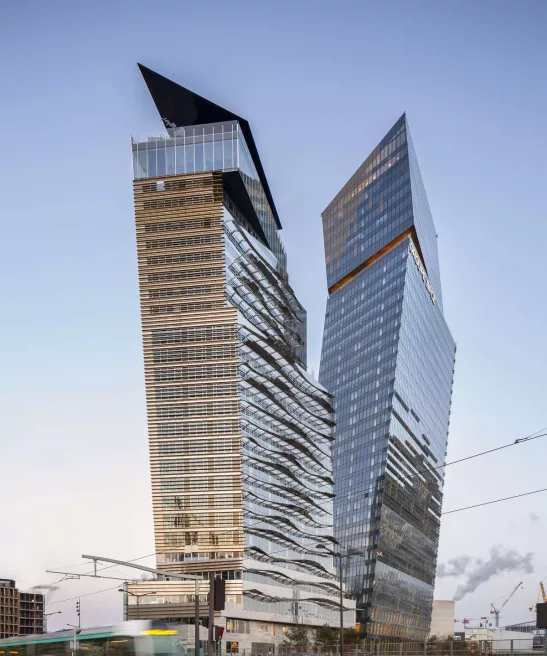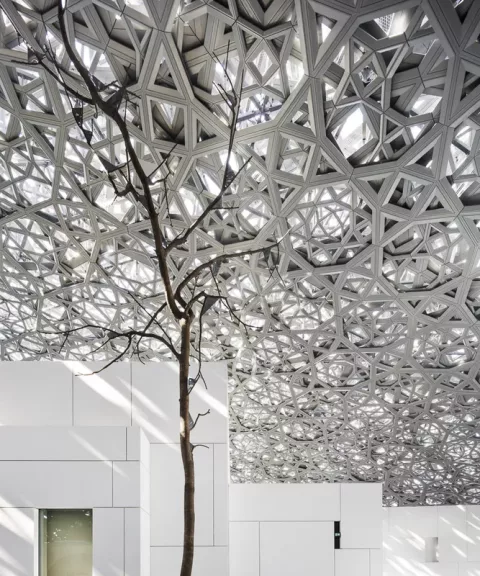His approach, which defies considerations of style, is guided only by the moment, the site, its history and its environment.
After studying at the École des Beaux-Arts in Bordeaux, Jean Nouvel was first admitted to the entrance examination for the École Nationale Supérieure des Beaux-Arts in Paris in 1966 and graduated in 1971.
First assistant to architect Claude Parent, inspired by urban planner and essayist Paul Virilio, he opened his first firm in 1970. Shortly thereafter, he co-founded the “Mars 1976” movement, the aim of which was to fight against the corporatisation of architects, then the Syndicat de l’Architecture.
His committed positions on the integration of architecture into the urban context and the constantly renewed originality of his projects throughout the world have contributed to forging his international image. His approach, which defies considerations of style, is guided only by the moment, the site, its history and its environment.


Recognition of his work has resulted in numerous awards in France and abroad. The Arab World Institute earned him the Aga Khan Award in 1989 for “his role as a successful bridge between French and Arab cultures”.
In 2000, he won the Golden Lion at the Venice Biennale. In 2001, he received three of the highest international distinctions: the Royal Gold Medal from the Royal Institute of British Architects (RIBA), the Praemium Imperiale from the Japanese Association of Fine Arts and the Borromini Award for the Lucerne Culture and Convention Centre.
He was named Doctor Honoris Causa at the Royal College of Art in London in 2002. Three years later, he received the Wolf Foundation’s annual prize in Israel for “his conception of a new model of contextuality and the redefinition of the dialectic between two features of contemporary architecture: the concrete and the ephemeral”.
The following year, for the Agbar Tower in Barcelona, he received the International Highrise Award in Frankfurt for “his outstanding contribution to the debate on great heights“.
In 2008, he received the prestigious Pritzker Prize. In France, he has been honoured with numerous awards including the gold medal from the French Academy of Architecture, two Silver T-squares and the Grand National Prize of Architecture in France.
In November 2017, Jean Nouvel delivered the Louvre Abu Dhabi museum, an emblematic museum in the Gulf Region. The museum has received unanimous international recognition and has already welcomed a large number of visitors since its opening.
In the field of design, Jean Nouvel produced his first pieces of furniture in 1987 as part of the "Cartes Blanches du Via".
In the field of design, Jean Nouvel produced his first pieces of furniture in 1987 as part of the “Cartes Blanches du Via”.
Subsequently, he developed several collections in conjunction with his architectural achievements: the Elementary armchair for the Tours Congress Centre (Matteo Grassi, Arflex 2015), the Saint James line for the Saint James Hotel in Bouliac (Ligne Roset), the Lyon theatre seats for the Opéra de Lyon (Figueras), the Less series (redeveloped in 2013 in aluminium under the name Less Less) for the Fondation Cartier in Paris (Unifor), the Vienna sofas for the Sofitel Hotel in Vienna (Wittmann, 2011), etc. In 1995, he created the company Jean Nouvel Design.
Jean Nouvel has now produced more than 100 furniture references, including the Quasi Normal desk (Bulo, 1996), the Touch series (Poltrona Frau, 1999), the Graduate shelf (Molteni, 2003), the Tower coffee service (Alessi, 2004), the Milana armchair (Sawaya & Moroni, 2005), the Skin sofa (Molteni, 2007), the L’Homme perfume (Yves Saint Laurent, 2007), the Mass seats (Moroso, 2007), the Riddle, Arana, Flying Surface and Paralum lamps (Troll, 2006-2008), the Grand Ecart table (Pallucco, 2008), the Martell Amber Lamp (Martell, 2010), the So So chairs (Emeco, 2012), the Mia seats (Emu, 2012), the Oxymore chair (Emu, 2012), the Essences collection (Eric Rouchon, 2012),
the Transcript system (Decayeux, 2012), the Chelsea handle (Olivari, 2012), the Less Less series (Unifor, 2013 ), the Cases system (Unifor, 2013), the Pure shoe line (Rucoline, 2013), the 1=2 table (Cassina, 2013), the Objective (Artemide, 2013) and Equilibrist (Artemide, 2014) lamps, the KNP seats (Arflex, 2014), the chandelier at Chateau La Dominique (Artemide, 2015) and the Philharmonia speakers (Amadeus, 2015). A collection for Roche Bobois (table, storage, chaise-longue, rug) (2016), marble rugs (Citco, 2016), a range of Reminiscences gold jewellery (Marbella, 2016), the new Pointillism Ground flooring (Bolon, 2016) and a line of seating made for Louvre Abu Dhabi (Poltrona Frau, 2016).
The year 2018 was marked by collaborations with MDF Italia (Super_Position shelf), Glas Italia (Encrypted Table and A mi Verre shelf), Nemo (Onlines Lamp) and Bottega Ghianda (Enigme a tics Game Table).
Since 2009, Jean Nouvel has developed three limited edition collections with the Gagosian Galleries and Patrick Seguin: Table au Km (2011), Boite à Outils (2011) and Triptyques (2014).
Opposite – the NVL table produced in 2020 by MDF Italia. The distinctive features of his architecture fully appear in this table and exalt the stylistic elements that have always characterised the work of Jean Nouvel: pure geometric shapes, formal lightness, graphic dimension and rigor.
Only buildings that are forgotten do not provoke debate
RBC Design Center
The flagship of the RBC group, this 2000 m² building was designed by Jean Nouvel.
In Montpellier, in the completely restructured ZAC Marianne district, the showroom takes the form of a 2,000 square meter parallelepiped, 18 meters high.
It has nine suspended levels organised around an exhibition hall. Each level is dedicated to an activity: kitchen, office furniture, outdoor furniture, lighting, a bookstore specialising in architecture and design, a boutique dedicated to objects, and a fashion and accessories lifestyle boutique.
“HYMN TO THE LIGHTNESS OF HORIZONTALITY”, JEAN NOUVEL.
Under the glass roof of the 1st floor of the Parisian RBC showroom, the scenography, signed Jean Nouvel Design, highlights the lightness and transparency of the design.
A free space has been kept in the centre of the room, to allow sufficient distance to admire and compare the different compositions. Each bookcase faces each other to parallel existing sizes and finishes.
The horizontal and vertical lines of each of the compositions, as well as their aerial configuration, respond to the lines of the glass roof where the exhibition is housed. A new reading of space is thus proposed, more geometric.
Formal lighting, graphic allure, sober design, harmonious aesthetics and essential character are the keywords for Super_Position, designed by Jean Nouvel. “The superpositions are a hymn to the lightness of horizontality. Crossed by the discontinuity of uninterrupted verticals, the planes are small diving boards which venture into the ambient void. Objects, vases and sculptures can express their differences in scale in the empty spaces, the niche spaces in the centre or at the ends of the superposed lines”. Jean Nouvel.
